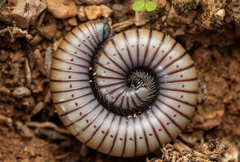Lumbricus terrestris

Lumbricus terrestris, commonly known as the earthworm, is a remarkable member of the Myriapoda class. While it plays an important role in ecosystems around the world, it is also of significant interest in the Comunidad Valenciana, where it contributes greatly to soil health and fertility.
These earthworms are characterized by their elongated, cylindrical bodies, which are segmented into numerous rings. Their bodies are usually reddish-brown or pinkish in color, and they can grow up to 25-30 cm in length. The segments help them move efficiently through the earth by contracting and expanding as they slide through the soil.
Habitat and Behavior
- Habitat: Lumbricus terrestris can be found in a wide range of habitats, but they thrive best in moist, rich soils with abundant organic matter.
- Behavior: These earthworms are primarily nocturnal, coming to the surface at night to feed on decaying leaves and plant material. During the day, they remain burrowed in the soil to escape predators and avoid desiccation.
Ecological Importance
- Soil Aeration: As they move through the soil, earthworms create channels that enhance soil aeration and water infiltration.
- Nutrient Cycling: Their feeding activity aids in breaking down organic matter, thus enriching the soil with nutrients and improving its structure.
- Food Source: Lumbricus terrestris serves as a crucial food source for a variety of birds, mammals, and other wildlife within the region.
In the Comunidad Valenciana, these earthworms are commonly referred to as 'lombrices de tierra' and are an integral part of the local ecological balance, promoting healthy landscapes and agricultural productivity.


